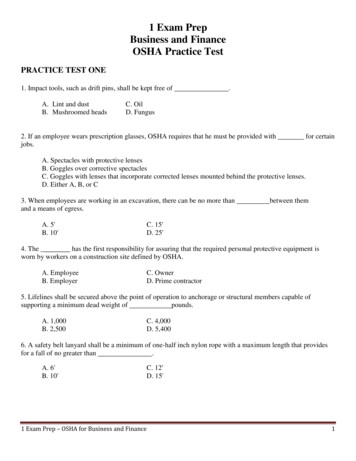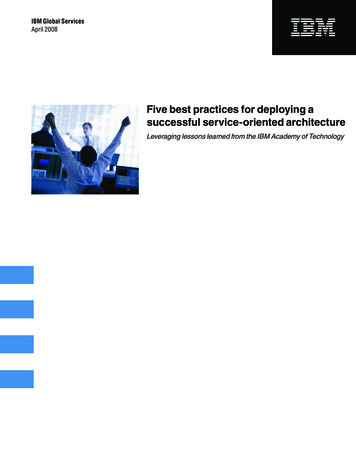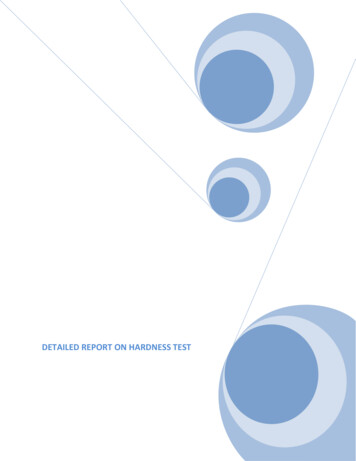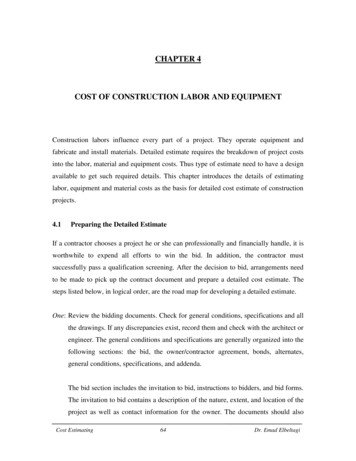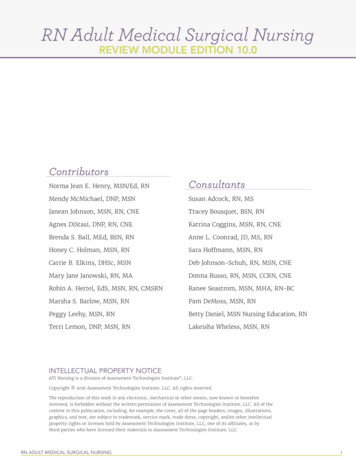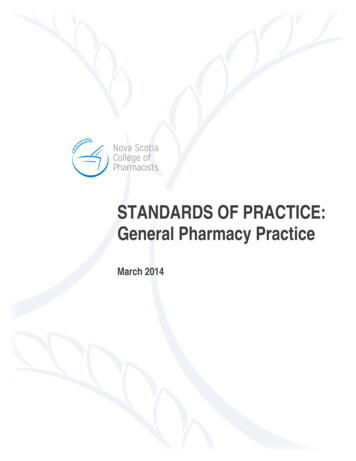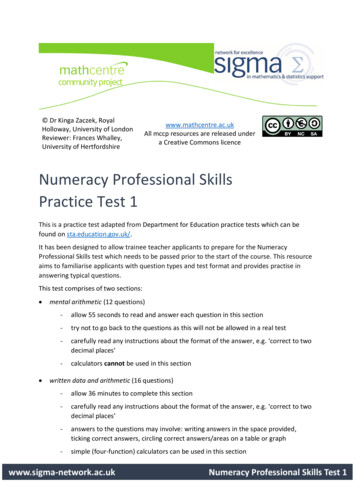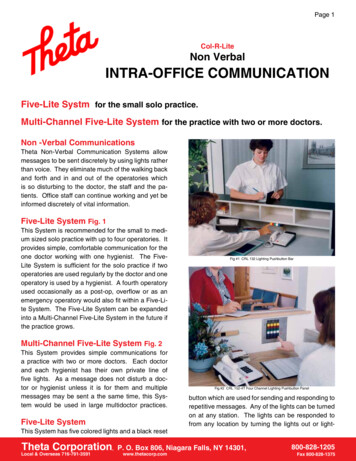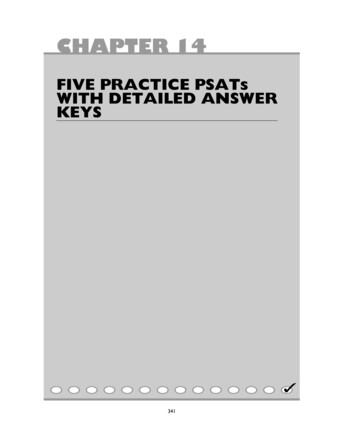
Transcription
CHAPTER 14FIVE PRACTICE PSATsWITH DETAILED ANSWERKEYS3X WX WX WX WX WX WX WX WX WX WX WX WX WXW341
PRACTICE PSAT 1343
CHAPTER 14 / PRACTICE PSAT 1345ANSWER SHEETLast Name:First Name:Date:Testing Location:Administering the Test Remove this answer sheet from the book and use it to record your answers to this test.This test will require 2 hours and 10 minutes to complete. Take this test in one sitting.Use a stopwatch to time yourself on each section. The time limit for each section is written clearly at thebeginning of each section. The first four sections are 25 minutes long, and the last section is 30 minutes long.Each response must completely fill the oval. Erase all stray marks completely, or they may be interpreted as responses.You must stop ALL work on a section when time is called.If you finish a section before the time has elapsed, check your work on that section. You may NOT move onto the next section until time is called.Do not waste time on questions that seem too difficult for you.Use the test book for scratchwork, but you will only receive credit for answers that are marked on theanswer sheets.Scoring the Test Your scaled score, which will be determined from a conversion table, is based on your raw score for eachsection.You will receive one point toward your raw score for every correct answer.You will receive no points toward your raw score for an omitted question.For each wrong answer on a multiple-choice question, your raw score will be reduced by 1/4 point. For eachwrong answer on a numerical “grid-in” question (Section 4, questions 29–38), your raw score will receive nodeduction.
346MC GRAW-HILL’S PSAT/NMSQT
CHAPTER 14 / PRACTICE PSAT 1347Section IÆzTime—25 minutes124 Questions (1 –24)Each of the sentences below is missing one or two portions. Read each sentence. Then select the choicethat most logically completes the sentence, taking into account the meaning of the sentence as a whole.Example:Rather than accepting the theory unquestioningly, Deborah regarded it with - - - - - - eskepticismCorrect response: (E)B1The seemingly offhand remark was in factpart of a - - - - - - effort by the director tomake the actors feel that their jobs were ationcorollaryacceptanceAlthough history has shown that the value ofour liberty is timeless, our appreciation ofsuch national - - - - - - seems all too often------.(A)(B)(C)(D)(E)B5B6benevolence . . solidvirtues . . fleetingconcepts . . permanentanachronisms . . transitorydiversions . . ephemeralJill Ker Conway’s autobiography explores the- - - - - - of childhood, the unexpected changesthat occur in a young life.(A)(B)(C)(D)(E)parasitism . . helpfulcooperation . . itemizedmortality . . precariousantagonism . . resourcefulsymbiosis . . beneficialDanitra knew at an early age that dancingwas her - - - - - -; it was what she was meantto do, and she pursued it with singleminded uiredreflexiveconventionalIn true - - - - - - , two different animal speciesdevelop a mutually - - - - - - relationship inthe same encevulnerabilitiesattachmentsMany scientists believe that an ancientsupernova may have - - - - - - human evolutionby bombarding the Earth with cosmic raysthat altered the global climate, thereby- - - - - - our ancestors to climb down fromthe trees and walk upright.(A)(B)(C)(D)(E)hastened . . pursuingresolved . . forcingterminated . . daringspurred . . impellingpropelled . . defyingGO ON TO THE NEXT PAGE Å Å Å
348MC GRAW-HILL’S PSAT/NMSQTB7Æz1When the Senator decided to - - - - - - his political party and affiliate himself with the opposition, he was understandably treated as- - - - - - by those former colleagues whom hehad left behind.(A)(B)(C)(D)(E)B8repudiate . . a curatorabandon . . a recluseascertain . . a championcomplement . . an expatriateforsake . . an apostateDespite the many attempts at - - - - - -, the dictator could not be assuaged, and the bellicosenature of his public announcements made itclear that conflict could not be - - - - - -.(A)(B)(C)(D)(E)diplomacy . . disclosedconciliation . . avertedtact . . denigratedbelligerence . . forestalledjingoism . . circumventedThe passages below are followed by questionsbased on their content and the relationshipbetween the passages. Answer each questionbased on what is stated or implied in thepassages.20Passage 22530354045Questions 9–12 are based on thefollowing passages.Passage 1Line51015I have given in to the practice, adopted longago by many of my colleagues, known as the“beginning-of-the-year review,” even thoughit abrades the very fiber of my being. It is,fundamentally, an admission of failure.Imagine the manager of a professional baseballteam spending the first few weeks of springtraining reviewing the names of the positions orin what direction to run the bases. Yet thestudents coming to us from the best highschools in America need to be reminded of themost fundamental academic tasks and tools—forming hypotheses, adding fractions,constructing a clear sentence. I can’t say withgreat certainty what is happening in our highschools, but I can say that glittering grades donot always indicate glittering minds. Thereseems to be no grounding, no sense of the# 2004 Christopher Black and College Hill Coaching. Published bypermission of the author.fundamental reasoning skills and concepts ofacademia. I often wonder if our high schoolsshouldn’t be spending more time making suretheir ladders are on secure footing beforesending so many students scrambling up.B9B10In every choreographed educational crisis,the “back to basics” line always kicks up itsheels the highest. The thinking is seeminglyirrefutable: our children won’t succeed withouta solid foundation in basic skills. They can’t docalculus before they learn long division. Theycan’t write a good college essay before theylearn the five-paragraph model. They can’t readShakespeare before learning the phonetic code.The model is the pyramid: we must build a solidfoundation if our children are ever to reachthe pinnacle of education, where the mostprofound questions of our era are examined.But we are losing too many students in buildingthe pyramid. It is worth the risk to take them tothe top of the pyramid, unfinished as it may be,so that they might see the glorious expanse ofknowledge before them, yet to be reached. If wedon’t take the time to show them that expanse,they will likely never learn that their hard laborhas any real purpose. We are too worried aboutfailure, about not getting the right answers, thatour questions and our tasks have lost almost allof their meaning.Passage 1 is written from the perspective of(A)(B)(C)(D)(E)aaaaapoliticiancollege professorhigh school teacherhigh school studentparentIn Passage 2, the “top of the pyramid” (line39) represents the point at which students(A)(B)(C)(D)have mastered all of the basic skillshave been accepted into collegehave acquired a degreecan glimpse the most challenging academic problems(E) can outperform other students on standardized testsGO ON TO THE NEXT PAGE Å Å Å
The two authors differ in their perspectiveson fundamental academic skills in that theauthor of Passage 1 believes that(A) they should not be taught, while theauthor of Passage 2 believes that theyform the foundation of a good education(B) they should be taught in high school,while the author of Passage 2 believesthat they should be taught in college(C) they are underemphasized in highschool, while the author of Passage 2believes that they are overemphasized(D) they can be mastered by all students,while the author of Passage 2 believesthat they are beyond the ability of somestudents(E) they are inimical to higher education,while the author of Passage 2 believesthat they should be the focus of acollege educationB121015202530Which of the following devices is used byBOTH personificationmetaphorThe questions below are to be answered on thebasis of what is stated or implied in thepassage below or the introductory materialthat precedes the passage.Questions 13–24 are based on thefollowing passages.35404550The following passages examine the work of F. ScottFitzgerald, the American twentieth-century novelist.Passage 1Line5Regarding most of the criticism and muchof Fitzgerald’s work, I am once again struck bythe urge to respond to Fitzgerald’s writing.Sometimes—often—that response is only anexclamation of delight. Other times it is a needto try to write out a response in one’s ownwords. This is no time, at the end of a briefintroduction, to be starting an essay onFitzgerald. What follows are some jottings5560occasioned by this encounter with Fitzgeraldand his critics.First, modern criticism (certainly not ofFitzgerald alone) is often too refined. The bigthings having been said, young critics tendto make too much of small things. Colorsymbolism, the guest list in The Great Gatsby,and the “gat” in “Gatsby” are examples of whatone hopes will not dominate criticism ofFitzgerald’s work in the future.Second, there is joy in Fitzgerald’s work thatshould not be passed over in dwelling uponprofundities, complexities, and tragicimplications. Edmund Wilson described it earlyas a “quality exceedingly rare among even theyoung American writers of the day; he is almostthe only one among them who has any reallight-hearted gaiety.” Recognizing that qualityand acknowledging its worth may drawattention to the variety to be found in a writerwho is commonly charged with having toonarrow a range. It also adds to the dimensionsof The Great Gatsby and Tender is the Night,those novels that do most to maintainFitzgerald’s reputation as a serious writer.For it is not only theme and technique thatdistinguish these novels, but the flashes ofbrilliance, comic as well as tragic, thatilluminate individual scenes.Third, Fitzgerald’s style, as has been saidover and over, is his great strength. Herescholarship has done a great service toFitzgerald. One’s awareness of his style isenhanced by examining the manuscriptsthrough which the finished phrases andparagraphs came into existence. One feelsbetter about one’s own strikeovers, andpencillings, and second and third thoughts.One learns.Fourth, in the presence of so muchFitzgerald scholarship, it is easy to becomeboth solemn and heavy about Fitzgerald, manand work. Perhaps there should be somelicensing procedure that would prevent badwriters, pretentious and heavy scholars, fromdealing with Fitzgerald. Lacking that, a readercan be grateful that, despite some notableexceptions, students as well as professionalcritics seem attracted to Fitzgerald out of acommon respect for his prose style and thestoryteller’s art. Like Fitzgerald’s work, much ofFitzgerald criticism is distinguished byextraordinary felicity of expression.GO ON TO THE NEXT PAGE Å Å ÅÆB11349zCHAPTER 14 / PRACTICE PSAT 11
350Æ65z170MC GRAW-HILL’S PSAT/NMSQTFinally, Fitzgerald will probably continue toclaim the interest of both the general readerand the scholar-critic. The mysteries of hisgenius, like the mysteries of his style, remain tobe pondered. As our own perspectives change,his various works will be seen in different lights.The final test of Fitzgerald, as of all writers,is that others want to read his works and toshare the pleasures they receive.B13The first paragraph of Passage 1 reveals thatthe author of Passage 1(A) has recently been introduced to Fitzgerald’s novels(B) has met F. Scott Fitzgerald personally(C) has been critical of many of Fitzgerald’searlier works(D) is writing an introduction to a book ofliterary criticism(E) is a novelistPassage 2After a brief revival, the novels of ScottFitzgerald seem destined again for obscurity,labeled this time, by their most recent critics, as75 darkly pessimistic studies of America’s spiritualand ideological failures. The Great Gatsby, weare now told, is not simply a chronicle of theJazz age but rather a dramatization of thebetrayal of the naı̈ve American dream in a80 corrupt society.From the start, Fitzgerald’s personal dreamsof romance contained the seeds of their owndestruction. In his earliest works, his optimisticsense of the value of experience is85 overshadowed by a personal intuition oftragedy; his capacity for naı̈ve wonder ischastened by satiric and ironic insights whichmake surrender to the romantic impulseincomplete. Though able to idealize the90 sensuous excitement of an exclusive party or alovely face, Fitzgerald could not ignore thespeciosity inherent in the romantic stimuli ofhis social world—in the unhurried graciouspoise that money can buy.95At the same time that Fitzgerald perceivedthe melancholy nature of romantic illusion, hisattitude towards the rich crystallized. The thirstfor money is a crucial motive in Gatsby as inFitzgerald’s other novels, and yet none of his100 major characters are materialists, for money isnever their final goal. The rich are tooaccustomed to money to covet it. It is simply thebadge of their “superiority” and the justificationof their consuming snobberies.105Inevitably then, Fitzgerald saw his romanticdream threaded by a double irony. Those whopossess the necessary means lack the will,motive, or capacity to pursue a dream. Thosewith the heightened sensitivity to the promises110 of life have it because they are the disinherited,forever barred from the white palace where “theking’s daughter, the golden girl” awaits “safeand proud above the struggles of the poor.”B14As it is used in line 13, “refined” most ned with minor detailschallengingpureThe author of Passage 1 mentions EdmundWilson in line 23 as an example of one who(A) has deeply explored the tragic implications of Fitzgerald’s novels(B) has written novels that were inspired byFitzgerald’s work(C) has criticized certain themes inFitzgerald’s novels(D) recognizes a quality in Fitzgerald’s worksthat others may overlook(E) focuses excessively on irrelevant aspectsof Fitzgerald’s styleB16In line 30, the phrase “charged with” mostnearly means(A)(B)(C)(D)(E)emboldened byweakened bygiven the responsibility ofelectrified byaccused ofF. Scott Fitzgerald: A Collection of Criticism, Kenneth E. Eble,#1973 McGraw-Hill, Passage 1: pp. 4– 6, Passage 2: pp. 60–65. Copyright 1956 by the National Council of Teachers ofEnglish. Reprinted with permission.GO ON TO THE NEXT PAGE Å Å Å
17The sentence “One learns” (line 48) isintended primarily to convey the idea thatB21(A) Fitzgerald’s editors often destroyed hisbest work(B) college English classes should studymore of Fitzgerald’s lesser-known novels(C) scholars should revisit Fitzgerald’snovels many times(D) most professors of literature enjoyFitzgerald’s prose(E) literary craft includes a good deal ofreworkingB18B19In saying that “Fitzgerald’s personal dreamsof romance contained the seeds of theirown destruction” (lines 81 –83), the authorof Passage 2 means that(A) Fitzgerald’s works have always lackedpopular appeal(B) Fitzgerald’s life was cut tragically short(C) Fitzgerald’s novels contain elements oftragedy(D) Fitzgerald was never satisfied with thequality of his own work(E) Fitzgerald’s romantic scenes wereunrealisticB20(A) He would reluctantly agree because hebelieves that readers are finding itincreasingly difficult to understandFitzgerald’s themes.(B) He would strongly agree, because hebelieves that Fitzgerald’s works arefatally flawed.(C) He would reluctantly disagree becausehe believes that they will continue to bea popular, but not a critical, success.(D) He would strongly disagree because hebelieves that Fitzgerald’s work will continue to have strong appeal.(E) He would suggest that the statement isirrelevant because the popularity ofFitzgerald’s novels is not important.The purpose of the fifth paragraph (lines49 –62) of Passage 1 is primarily to expressthe author’s concern about(A) the unrestricted access to Fitzgerald’spersonal archives(B) the tone and quality of some criticismabout Fitzgerald(C) insufficient seriousness in criticismabout Fitzgerald(D) the excessive quantity of criticism aboutFitzgerald(E) the difference in quality betweenthe work of students and the work ofprofessional scholarsHow would the author of Passage 1 likelyrespond to the statement made in Passage 2that “the novels of Scott Fitzgerald seem destined again for obscurity” (lines 72 –73)?B22How does the “joy” (line 20) mentioned inPassage 1 differ from the “wonder” (line 86)mentioned in Passage 2?(A) The “joy” is regarded as something thatmakes Fitzgerald’s work distinctive,while the “wonder” is regarded as beingcompromised.(B) The “joy” is regarded as insincere, whilethe “wonder” is regarded as too blatant.(C) The “joy” is regarded as a flaw inFitzgerald’s work, while the “wonder” isregarded as a positive feature of hiswork.(D) The “joy” is regarded as somethingunique in American literature, while the“wonder” is regarded as being commonto most novels of the twentieth century.(E) The “joy” is regarded as a feature ofFitzgerald’s life, while the “wonder” isregarded as a feature of Fitzgerald’swork, but not his life.The “white palace” (line 111) represents(A)(B)(C)(D)(E)the distinctive status of writersmoral superiorityliterary perfectiona life of privilegepower acquired by forceGO ON TO THE NEXT PAGE Å Å ÅÆB351zCHAPTER 14 / PRACTICE PSAT 11
352B23Æz1MC GRAW-HILL’S PSAT/NMSQTWhich statement would most likely be supported by the authors of both passages?(A) Some critics of Fitzgerald’s work havefocused on the tragic implications of hisnovels.(B) Fitzgerald’s works are even more populartoday than they were in his time.(C) The characters in The Great Gatsby arematerialists.(D) Fitzgerald’s works are far more optimistic than many believe.(E) Scholarship on Fitzgerald’s works shouldfocus more on their style than on theirthemes.STOPB24How would the author of Passage 1 likelyrespond to the analysis of Fitzgerald’s workpresented in lines 81 –94?(A) He would disagree with its claim thatFitzgerald had a “capacity for naı̈vewonder.”(B) He would agree with its focus on irony.(C) He would regard it as an unnecessaryfocus on the tragic aspects of Fitzgerald’sworks.(D) He would regard it as insufficiently critical of Fitzgerald’s choice of theme.(E) He would suggest that it ignores important details about Fitzgerald’s personallife that would explain the themes in hisworks.You may check your work, on thissection only, until time is called.
CHAPTER 14 / PRACTICE PSAT 1353Section 2Time—25 minutesÆ20 Questionsz2Directions for Multiple-Choice QuestionsIn this section, solve each problem, using any available space on the page for scratchwork. Then decidewhich is the best of the choices given and fill in the corresponding oval on the answer sheet.You may use a calculator on any problem. All numbers used are real numbers.Figures are drawn as accurately as possible EXCEPT when it is stated that the figure is not drawnto scale.All figures lie in a plane unless otherwise indicated.Reference InformationThe arc of a circle measures 3608.Every straight angle measures 1808.The sum of the measures of the angles in a triangle is 1808.B1The area of a rectangle with a height of 4 cmand a base of 6 cm is how many times greaterthan the area of a triangle with a height of4 cm and a base of 4 cm?(A)(B)(C)(D)(E)B4(A)(B)(C)(D)(E)11.522.53B5B2If x ¼ 2y þ 2, how much greater is 6x than12y?(A)(B)(C)(D)(E)B32681224How many integers between 10 and 40 aredivisible by both 2 and 6?(A)(B)(C)(D)(E)TwoThreeFourFiveSixIf it is now 4:30 p.m., what time will it beexactly 100 hours from now?4:30 p.m.8:30 p.m.12:30 a.m.2:30 a.m.4:30 a.m.Carrie, Denise, and Emily sold a total of 48candy bars. If Emily sold four times asmany candy bars as Denise did, and Denisesold three times as many candy bars asCarrie did, how many candy bars didDenise sell?(A)(B)(C)(D)(E)3691215GO ON TO THE NEXT PAGE Å Å Å
354MC GRAW-HILL’S PSAT/NMSQTBB692x Æz23x In a certain homeroom, the number of girls is6 less than twice the number of boys. If theclass contains b boys, which of the followingwould express the total number of studentspresent in the class if 2 girls were absent?(A)(B)(C)(D)(E)y Note: Figure not drawn to scale.2b 2 82b 2 43b 2 83b 2 63b 2 4In the figure above, what is the value of y?(A)(B)(C)(D)(E)B77260483640B10(A)(B)(C)(D)(E)Let the function f (x) be defined by theequation f(x) ¼ 2x 2 x 2. Which of the following has a positive value?(A)(B)(C)(D)(E)If (x þ 5)2 ¼ 0,(x 2 1)(x þ 1)?Bwhatisthevalueof2262240242611f (0.5)f (0)f (20.5)f (21.5)f (22.5)lABCB8yNote: Figure not drawn to scale.In the figure above, the circle with center at Chas a circumference of 6p. If line ‘ is tangentto the circle and AB ¼ 4, what is the distancefrom B to C?l1(A)(B)(C)(D)(E)xO1What is the equation of line ‘ in the figureabove?4.85.06.27.07.2(A) y ¼ 2x þ 31(B) y ¼ x þ 321(C) y ¼ x þ 621(D) y ¼ x þ 32(E) y ¼ 2x þ 6B12A set consists of five consecutive integers.The sum of these integers is 210. What isthe greatest possible product that can beobtained by multiplying three different integers from this set?(A)(B)(C)(D)(E)224260624GO ON TO THE NEXT PAGE Å Å Å
13The first day of a 30-day month is a Monday.Which of the following is closest to the probability that a day picked at random from thismonth will be a 7B18If jxj . 2, which of the following statementsmust be true?I. x . 0II. x 2 . 2III. x 3 . 2(A)(B)(C)(D)(E)B15B19A jar contains only red, white, and bluemarbles. If the number of red marbles is 56the number of white marbles, and the6number of red marbles is the number of7blue marbles, what is the least possiblenumber of marbles in the jar?(A)(B)(C)(D)(E)16BII onlyI and II onlyI and III onlyII and III onlyI, II, and IIIThe graph of which of the following points is2below the graph of the line y ¼ x þ 1?3(A) (21, 1)(B) (1, 1)(C) (1, 2)(D) (3, 3)(E) (4, 4)If 3n21 ¼ 2721, then n ¼(A)(B)(C)(D)(E)232221121¼ y, where x 0, which of thex1following expresses x2 þ 2 in terms of y?x(A) y 2 þ 2(B) y 2 þ 1(C) y 2(D) y 2 2 1(E) y 2 2 2If x þB20ylA1872101113123O(16,0)8, a, b, 27(6,0)In the sequence above, each term, except thefirst, is equal to the previous term times abconstant. What is the value of ?a(A) 1.125(B) 1.50(C) 3.375(D) 4.75(E) 6.33Note: Figure not drawn to scale.STOPxIf line ‘ in the figure above has a slope of 2,what are the coordinates of point A?(A)(B)(C)(D)(E)(0, 7.2)(0, 13.2)(0, 14.4)(0, 18.4)(0, 19.2)You may check your work, on thissection only, until time is called.ÆB355zCHAPTER 14 / PRACTICE PSAT 12
356MC GRAW-HILL’S PSAT/NMSQTSection 3Time—25 minutes24 Questions (25– 48)Æz3Each of the sentences below is missing one or two portions. Read each sentence. Then select the choicethat most logically completes the sentence, taking into account the meaning of the sentence as a whole.Example:Rather than accepting the theory unquestioningly, Deborah regarded it with -- ranceskepticismCorrect response: (E)B25Unlike most farmers, who regarded rain as agreat benefit, Harold often regarded it as--- ---.(A)(B)(C)(D)(E)B26B2728an abundancea hardshipa schemea responsea distortionPablo Picasso is considered - --- -- of artisticperfectionism because he would destroy anyof his works that he considered -- ----.(A)(B)(C)(D)(E)Ban enemy . . pooran example . . beautifula paragon . . mediocrea proponent . . aesthetican advocate . . monetaryThe store employees tried to -- --- - the angryshoppers with offers of discounted merchandise and free gift ilferabridgeSome European governments are concernedthat severe immigration restrictions, whilerendering nations less --- --- to foreign terrorists, would also - --- -- the influx of creativeideas from abroad.(A)(B)(C)(D)(E)pervious . . stemimpregnable . . haltdurable . . promotepenetrable . . hastenpotent . . restrictJoseph often picked fights with anyone whochallenged his ideas, until his friends madeit clear that such --- --- was ortituderestrainteloquenceGO ON TO THE NEXT PAGE Å Å Å
CHAPTER 14 / PRACTICE PSAT 1Questions 32–33 are based on thefollowing passage.5Questions 30– 31 are based on thefollowing passage.Line5101520B30B31Historical evidence takes many forms,including oral traditions and archaeology aswell as written texts. Study of the very distantpast necessarily relies primarily on oraltraditions and archaeology; these two kinds ofevidence offer different perspectives on the pastand answer different historical questions. Oraltradition is the means by which knowledge—both fact and myth—was passed on until it waswritten down. Archaeology, in contrast, is thescientific study of the material remains of pasthuman life and activities: fossil relics, artifacts,and monuments. Archaeology supplies physicalevidence of material culture, while oral sourcesprovide insight into the nonmaterial world ofideas, values and beliefs. Archaeologicalinvestigation may present evidence frommillions of years before the present or from themost recent historical past. Oral traditions,some of which are ultimately written down, aremore ephemeral, extending across a singlelifetime or as far back as the past 10,000 yearsor so of remembered human experience.10152025B32The primary purpose of this passage is to(A) promote the study of archaeology(B) describe different oral traditions(C) discuss a few important historical discoveries(D) compare two means of gathering information(E) suggest an improvement to the study ofarchaeologyThe passage indicates that the “nonmaterialworld of ideas, values and beliefs” (lines15 –16) is(A) a subject that only archaeologists canstudy(B) not sufficiently emphasized in historicaltexts(C) an unreliable source of historicalevidence(D) evidence of material culture(E) the substance of oral traditionB33After having—with agony and despair—lived through the irrational tidal waves of thelast big war, the world of planners settled downto a rose-colored rational optimism: “To giveeducation, food and health care would sufficeto bring peace and stability to this world;satisfying the ‘basic needs’ for information andacceptable material living conditions wouldguarantee mutual understanding anddemocratic tolerance within and betweennations.” This belief has been badly shaken bynow; we are beginning to see that man is notrational enough to make the expected use of theimprovements achieved in the last 30 years,that unrest, prejudice, ideological distortion,and violence do not come from the poor (whomight have most reason for such reactions), butto a considerable extent from the well-cared-forand well-educated classes in many nations—byno means always the most underdevelopedones—of the world. We discover that realitydoes not conform to our rational prescriptions,and we are forced to ponder whether ourpresent level of rationality is at all adequate fordealing with the problems of our world.This passage most directly ionalitytechnologyThe parenthetical comment in lines 16 –17indicates that the poor(A) are ignored by the more affluent classes(B) should be granted more political power(C) are more justified than the wealthy inacting rebelliously(D) should be the focus of postwar planning(E) have talents that are underappreciated inmodern societiesFirst paragraph: In the Balance: Themes in Global History, CandiceL. Goucher, Charles A. Le Guin, Linda A. Walton, #1998McGraw-Hill, p xxxiSecond paragraph: Culture and Industrialization: An AsianDilemma, Rolf E. Vente, Peter S.J. Chen, #1980 McGraw-Hill,p 52GO ON TO THE NEXT PAGE Å Å ÅÆLinezEach passage below is followed by one or twoquestions based on its content. Answer eachquestion based on what is stated or impliedin the passage that precedes it.3573
358MC GRAW-HILL’S PSAT/NMSQTQuestions 34 – 40 are based on thefollowing passage.The following is an excerpt from a story writtenby a twentieth-century Yugoslav writer.ÆLinez35101520253035404550I like to get up early and go down to sit onmy bench by the bank of the river just at thecrack of dawn, before even the sparrows areawake and before the traffic has begun to makeits daily assault on my nerves. The men withhoses have just set out to clean the pavements,everything is quiet and happy, just as it musthave looked a million years ago. The rivergurgles along, clean and gay, rejoicing at itsbrief moment of rest before the beginning ofanother exhausting day. I’m no hermit ormisanthrope. Just every now and again I get fedup with everything, and I mean everything, and Ifeel the need to be alone, completely alone. Butnot for long, for in fact without that“everything,” I can’t get along either. Peopleand things simply get me down; maybe becauseboth are human products, and there’ssomething of that exhausted human core thatremains in them too. And so I start to want tochange. The fashionable word for it isrecreation. We used to have our own word forit. Maybe it doesn’t convey everything that theforeign one does, but in any case none of that isso very important as long as a man does have arest and get his strength back regularly. That’sthe thing that we haven’t managed to pull out ofour dusty old dictionaries. Anyway, I go offdown to the river to get my strength back. Andthat’s really what happens; I come to life again.I may have come to our appointment with aheavy, care-worn head, or I may have beenthinking all the way about what I might do toavoid this or that; still when I arrive, my bodyseems to become light and my mind keen; andthe river’s quiet friendly voice restores the joyand hope that had fled before trivial everydayanxieties and become hidden away in thedarkest gloom. I’ve seldom met anyone w
Remove this answer sheet from the book and use it to record your answers to this test. This test will require 2 hours and 10 minutes to complete. Take this test in one sitting. . CHAPTER 14 / PRACTICE PSAT 1 345. 346 MCGRAW-HILL’S PSAT/NMSQT. Section I Time—25 minutes 24 Qu

